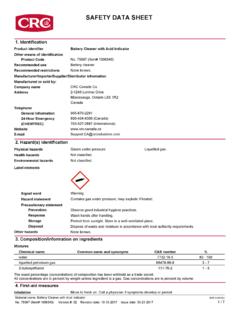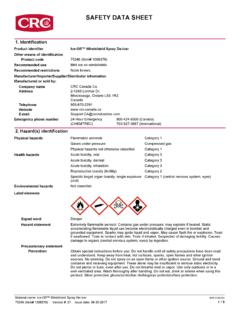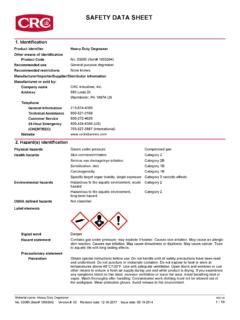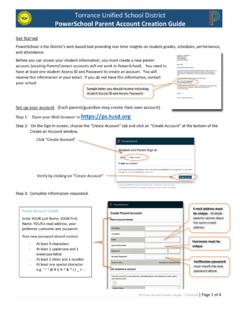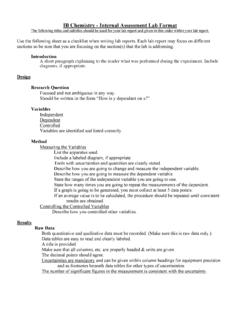Transcription of SAFETY DATA SHEET - CRC Industries
1 SAFETY data SHEET . 1. Identification Product identifier Battery Terminal Protector Other means of identification Product Code No. 03175 (Item# 1003433). Recommended use Battery terminal protector Recommended restrictions None known. Manufacturer/Importer/Supplier/Distribut or information Manufactured or sold by: Company name CRC Industries , Inc. Address 885 Louis Dr. Warminster, PA 18974 US. Telephone General Information 215-674-4300. Technical Assistance 800-521-3168. Customer Service 800-272-4620. 24-Hour Emergency 800-424-9300 (US). (CHEMTREC) 703-527-3887 (International). Website 2. Hazard(s) identification Physical hazards Flammable aerosols Category 1. Gases under pressure Liquefied gas Health hazards Skin corrosion/irritation Category 2. Serious eye damage/eye irritation Category 2A. Carcinogenicity Category 2. Reproductive toxicity (fertility) Category 2. Specific target organ toxicity, single exposure Category 3 narcotic effects Specific target organ toxicity, repeated Category 2 (central nervous system, kidney, exposure (oral) liver).
2 Aspiration hazard Category 1. Environmental hazards Hazardous to the aquatic environment, acute Category 1. hazard Hazardous to the aquatic environment, Category 1. long-term hazard OSHA defined hazards Not classified. Label elements Signal word Danger Hazard statement Extremely flammable aerosol. Contains gas under pressure; may explode if heated. May be fatal if swallowed and enters airways. Causes skin irritation. Causes serious eye irritation. May cause drowsiness or dizziness. Suspected of causing cancer. Suspected of damaging fertility. May cause damage to organs (central nervous system, kidney, liver) through prolonged or repeated exposure by ingestion. Very toxic to aquatic life. Very toxic to aquatic life with long lasting effects. Material name: Battery Terminal Protector SDS US. No. 03175 (Item# 1003433) Version #: 04 Revision date: 10-12-2017 Issue date: 10-21-2013 1 / 15. Precautionary statement Prevention Obtain special instructions before use.
3 Do not handle until all SAFETY precautions have been read and understood. Keep away from heat/sparks/open flames/hot surfaces. - No smoking. Do not spray on an open flame or other ignition source. Pressurized container: Do not pierce or burn, even after use. Do not apply while equipment is energized. Extinguish all flames, pilot lights and heaters. Vapors will accumulate readily and may ignite. Use only with adequate ventilation;. maintain ventilation during use and until all vapors are gone. Open doors and windows or use other means to ensure a fresh air supply during use and while product is drying. If you experience any symptoms listed on this label, increase ventilation or leave the area. Do not breathe mist or vapor. Wear protective gloves/protective clothing/eye protection/face protection. Wash thoroughly after handling. Avoid release to the environment. Response If swallowed: Immediately call a poison center/doctor. Do NOT induce vomiting. IF ON SKIN: Wash with plenty of soap and water.
4 If skin irritation occurs: Get medical attention. Take off contaminated clothing and wash before reuse. If inhaled: Remove person to fresh air and keep comfortable for breathing. Call a poison center/doctor if you feel unwell. If in eyes: Rinse cautiously with water for several minutes. Remove contact lenses, if present and easy to do. Continue rinsing. If eye irritation persists: Get medical attention. If exposed or concerned: Get medical attention. Collect spillage. Storage Store in a well-ventilated place. Store locked up. Protect from sunlight. Do not expose to temperatures exceeding 50 C/122 F. Exposure to high temperature may cause can to burst. Disposal Dispose of contents/container in accordance with local/regional/national regulations. Hazard(s) not otherwise Static accumulating flammable liquid can become electrostatically charged even in bonded and classified (HNOC) grounded equipment. Sparks may ignite liquid and vapor. May cause flash fire or explosion.
5 3. Composition/information on ingredients Mixtures Chemical name Common name and synonyms CAS number %. liquefied petroleum gas 68476-86-8 20 - 30. n-heptane 142-82-5 10 - 20. petrolatum 8009-03-8 10 - 20. 2-methylpentane 107-83-5 5 - 10. 3-methylhexane 589-34-4 5 - 10. naphtha (petroleum), hydrotreated 64742-49-0 5 - 10. light 2-methylhexane 591-76-4 3-5. heptane, branched, cyclic and 426260-76-6 3-5. linear methylcyclohexane 108-87-2 3-5. solvent naphtha (petroleum), light 64742-89-8 3-5. aliph. 3-ethylpentane 617-78-7 1-3. ethylbenzene 100-41-4 1-3. n-hexane 110-54-3 1-3. paraffin oils (petroleum), catalytic 64742-70-7 1-3. dewaxed heavy xylene 1330-20-7 1-3. 3,3-dimethylpentane 562-49-2 <1. toluene 108-88-3 < 2,2-dimethylbutane 75-83-2 < 2,3-dimethylbutane 79-29-8 < 3-methylpentane 96-14-0 < Specific chemical identity and/or percentage of composition has been withheld as a trade secret. 4. First-aid measures Inhalation Remove victim to fresh air and keep at rest in a position comfortable for breathing.
6 Call a POISON. CENTER or doctor/physician if you feel unwell. Skin contact Remove contaminated clothing. Rinse skin with water/shower. If skin irritation occurs: Get medical advice/attention. Wash contaminated clothing before reuse. Material name: Battery Terminal Protector SDS US. No. 03175 (Item# 1003433) Version #: 04 Revision date: 10-12-2017 Issue date: 10-21-2013 2 / 15. Eye contact Immediately flush eyes with plenty of water for at least 15 minutes. Remove contact lenses, if present and easy to do. Continue rinsing. Get medical attention if irritation develops and persists. Ingestion Call a physician or poison control center immediately. Rinse mouth. Do not induce vomiting. If vomiting occurs, keep head low so that stomach content doesn't get into the lungs. Most important Aspiration may cause pulmonary edema and pneumonitis. May cause drowsiness and dizziness. symptoms/effects, acute and Narcosis. Headache. Nausea, vomiting. Behavioral changes.
7 Decrease in motor functions. Severe delayed eye irritation. Symptoms may include stinging, tearing, redness, swelling, and blurred vision. Skin irritation. Vapors have a narcotic effect and may cause headache, fatigue, dizziness and nausea. May cause redness and pain. Edema. Jaundice. Prolonged exposure may cause chronic effects. Indication of immediate Provide general supportive measures and treat symptomatically. Keep victim under observation. medical attention and special Symptoms may be delayed. treatment needed General information IF exposed or concerned: Get medical advice/attention. Ensure that medical personnel are aware of the material(s) involved, and take precautions to protect themselves. Show this SAFETY data SHEET to the doctor in attendance. 5. Fire-fighting measures Suitable extinguishing media Water fog. Foam. Carbon dioxide (CO2). Dry chemical powder, carbon dioxide, sand or earth may be used for small fires only. Unsuitable extinguishing Do not use water jet as an extinguisher, as this will spread the fire.
8 Media Specific hazards arising from Contents under pressure. Pressurized container may rupture when exposed to heat or flame. This the chemical product is a poor conductor of electricity and can become electrostatically charged. If sufficient charge is accumulated, ignition of flammable mixtures can occur. Static electricity accumulation may be significantly increased by the presence of small quantities of water or other contaminants. Material will float and may ignite on surface of water. During fire, gases hazardous to health may be formed. Special protective equipment Firefighters must use standard protective equipment including flame retardant coat, helmet with and precautions for firefighters face shield, gloves, rubber boots, and in enclosed spaces, SCBA. Fire-fighting In case of fire: Stop leak if safe to do so. Move containers from fire area if you can do so without equipment/instructions risk. Containers should be cooled with water to prevent vapor pressure build up.
9 General fire hazards Extremely flammable aerosol. Contents under pressure. Pressurized container may rupture when exposed to heat or flame. 6. Accidental release measures Personal precautions, Keep unnecessary personnel away. Keep people away from and upwind of spill/leak. Remove all protective equipment and possible sources of ignition in the surrounding area. Keep out of low areas. Many gases are emergency procedures heavier than air and will spread along ground and collect in low or confined areas (sewers, basements, tanks). Wear appropriate protective equipment and clothing during clean-up. Do not breathe mist or vapor. Emergency personnel need self-contained breathing equipment. Do not touch damaged containers or spilled material unless wearing appropriate protective clothing. Ventilate closed spaces before entering them. Use appropriate containment to avoid environmental contamination. Local authorities should be advised if significant spillages cannot be contained.
10 For personal protection, see section 8 of the SDS. Methods and materials for Eliminate all ignition sources (no smoking, flares, sparks, or flames in immediate area). Keep containment and cleaning up combustibles (wood, paper, oil, etc.) away from spilled material. Prevent product from entering drains. Stop the flow of material, if this is without risk. Wipe up with absorbent material ( cloth, fleece). Clean surface thoroughly to remove residual contamination. Put material in suitable, covered, labeled containers. For waste disposal, see section 13 of the SDS. Environmental precautions Avoid release to the environment. Inform appropriate managerial or supervisory personnel of all environmental releases. Prevent further leakage or spillage if safe to do so. Avoid discharge into drains, water courses or onto the ground. Use appropriate containment to avoid environmental contamination. Material name: Battery Terminal Protector SDS US. No. 03175 (Item# 1003433) Version #: 04 Revision date: 10-12-2017 Issue date: 10-21-2013 3 / 15.



